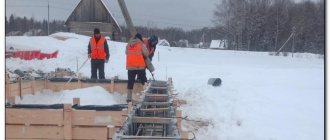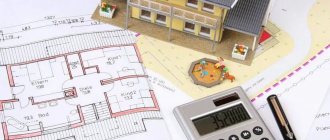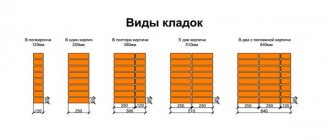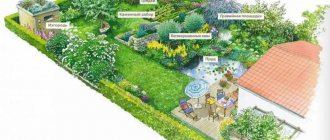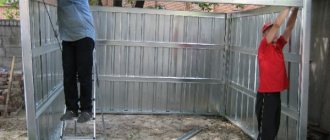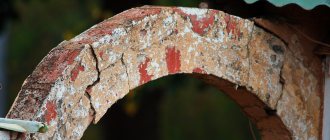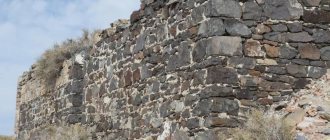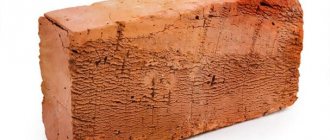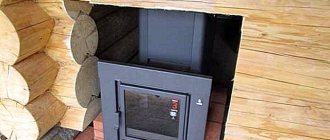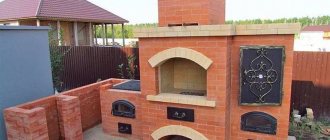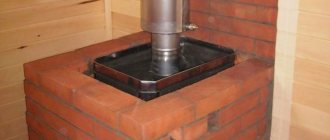These Old Believers are surprised when they shout that fire-resistant bricks are not needed in the furnace.
Such fanaticism among practicing stove makers looks especially incomprehensible and strange.
Or do they change their addresses and appearances after each stove, or do their customers feel sorry for them?
Please understand correctly, I am not judging anyone, I just don’t understand this position and I don’t understand what they are counting on and what their motivation is.
Here is another oven without refractory, let's look at the result.
Why is red brick better?
The material is based on environmentally friendly raw materials – clay. Unlike white brick, which is produced using limestone, red brick does not require additional processing. The building material is resistant to moisture and frost, having stable thermal insulation properties. Brick retains heat well.
Interesting materials:
How many calories are in one hundred grams of ready-made oatmeal? How many calories are in a tablespoon of flower honey? How many calories are in braised pork ribs? How many calories are in Boiled Pumpkin? How many calories are in Baked Skinless Chicken Thigh? How many calories are in Golden Step? How many canals are there in the 7th tooth from below? How many channels are included in the extended TV package? How many drops of orange oil per bath? How many castes are there in modern India?
Furnace consumer goods.
No matter what anyone thinks of themselves, most of us churn out consumer goods and unfortunately, or maybe fortunately, I am no exception.
If earlier consumer goods among stoves were warm but crooked , with doors swinging on burnt wire, with falling plaster that had to be renewed every year, etc., then today's consumer goods are warm, smooth and strong.
Technologies in construction, not only stoves, have moved towards visualization.
Modern heating stove.
From modern stoves, along with warmth, they began to demand beauty and strength.
The industrial production of bricks has changed a lot; they have learned to make ceramic bricks that are smooth and beautiful, but at the same time, they sacrificed their fire resistance.
Because of this change, the technology for building brick kilns has also changed.
Please note that I am talking about the construction of furnaces, not masonry, and this is not accidental.
Some people think these changes are unnecessary, but, in my opinion, without changes there is no evolution.
What has changed in furnace technology?
- Fireclay lining of all areas exposed to fire.
- The use of cast, heat-resistant concrete elements inside the furnace.
- A more reliable method of attaching stove fittings.
The photographs of the process of laying this stove, provided by its owner, clearly ignore the methods proposed above.
Lining of brick kilns.
An essential element of a modern, heat-intensive stove is a fireproof firebox .
Unfortunately, modern brick cannot withstand fire.
There is no escape from this, all that remains is to take it for granted and play by the rules.
The furnace firebox is destroyed by fire.
Fireproof lintels.
In the video below, I talk about fire-resistant lintels and their use.
How to prepare the solution?
The mortar for laying fireclay bricks is mainly sand-clay (or not used at all). The connection itself is made with your own hands or you use fireclay mortar - a fine powder, which, when water is added, forms the necessary consistency of the mixture (sand should contain grains up to 2.5 mm in size).
The powder, with the gradual addition of clean water, is beaten to medium (sour cream-like) consistency with a construction mixer or an alternative tool. Then the solution needs to sit for about an hour, after which the composition is kneaded again. The main indicator of quality is the similarity of the fireproof characteristics of the mixture with the bricks for laying. To ensure the strength of the mixture, you can add Portland cement (1/6 relative to the entire mass of the mixture) or 100-150 grams of salt per bucket of solution.
How to prepare the mixture yourself?
- water;
- fireclay sand;
- ground fire clay.
The clay must be soaked in water for up to 3 days in advance, stirring occasionally. When the material is ready, it is rubbed through a sieve (with divisions of 3x3 mm). Next, sand, sifted through a fine sieve, is gradually added to the clay. It is added in a ratio of 6:1 (for 100 blocks use 3 buckets of solution, or 40 kg of dry mixture). It is not recommended to place quartz sand, granite or marble chips. It is best to use special sand (a refractory block crushed into crumbs). The ingredients are mixed dry and only then water is added.
Height adjustment
To adjust the height of the heating device, special bolts are used, which are installed on its legs, or using supports. To set the required distance from the bottom of the firebox of a brick structure to the floor, lay several rows of bricks. Basic requirements before placing the combustion chamber in height:
you need to ensure a distance to the floor of 300-400 mm; if there is a niche for firewood under the firebox, this distance may be greater; When calculating the placement of the bottom of the combustion chamber, please note that you need to take into account the structure of the floor with all its components. Think about this when planning your heating system.
Fireplace size calculation
Fireplace size calculation
Let's determine the heat loss of our home
We need to understand how much energy consumption will be required to maintain the desired temperature in the house. The easiest way to do this is experimentally.
| Here is a selection of materials: IN Everything you need to know about heating and climate control Features of the selection and maintenance of boilers and burners. Comparison of fuels (gas, diesel, oil, coal, wood, electricity). Do-it-yourself ovens. Coolant, radiators, pipes, heated floors, circulation pumps. Chimney cleaning. Conditioning |
In cloudy, windy weather, close all windows, doors, ventilation openings in the house, and turn off all equipment, for example, the refrigerator. We don’t cook anything in the house; it’s better not to be in it at all. We open all internal doors to form a single space. Leave it like this for a day. After a day, we measure the temperature. It is better to measure in all rooms and average.
Now we turn on the electric heater, with a power of, for example, 1 kilowatt. If there are many rooms, then you can turn on several low-power heaters in different rooms. Again we leave it for a day. After a day, we measure the temperature. Again, it is better to measure in all rooms and average.
This experiment can be done at any time of the year. Basic temperature values do not affect the result, only relative changes are important. But it is necessary to conduct the experiment in cloudy weather. Sunlight, especially the infrared component, will spoil all measurements. And you need wind, since heat loss with wind is usually several times higher than without it.
We calculate the difference in average temperature without and with heaters. Divide by the power of the heaters in kilowatts. We get a number that shows how many degrees Celsius the temperature in the house rises from a one-kilowatt heater. In my house it turns out to be 10 degrees per kilowatt.
Correct definition of parameters
A corner fireplace, the dimensions of which have already been calculated, can be made of any materials and have a certain lining of the hearth. Before making your choice, we recommend that you familiarize yourself with the following selection rules:
Criterias of choice
Detailed description
Decorative hearths
The dimensions of a corner fireplace largely depend on the type of hearth chosen for installation and the fuel used for its operation.
If you are looking for a purely decorative solution or a firebox that will serve as an additional source of heating for your house or apartment, we recommend that you pay attention to fireplaces that operate using bioethanol or electricity.
Effective foci
Installation instructions for the finished model are always included in the basic package. The most effective fireplaces that can become the main source of heating in rooms are gas and classic wood-burning structures. If installing a gas boiler is possible both in a private and apartment building, then wood-burning fireboxes require a chimney, which is only possible in your own home. It should be noted that the installation of such installations is more complex, costly and time-consuming.
Budget materials
The chosen finish, materials for making the hearth and portal also play a big role. The most inexpensive and budget coatings are plasterboard, metal profiles, ceramic tiles, and decorative plaster. Due to their low cost, the design of portals, fireplaces or such cladding provides lower efficiency and efficiency.
Expensive coatings
The price of materials and coatings that form and provide the furnace with additional heat capacity, efficiency, and heat transfer is quite high. This category includes tiles, natural minerals, cast iron, steel
The distinctive features of the materials are practicality, durability, fire resistance, easy maintenance and environmental friendliness.
Preparation
Before attaching fireclay bricks to the mortar, it is better to select and grind the selected blocks by dry laying. If necessary, the brick is pre-pressed to achieve maximum density between the blocks. At this stage, you will need a feeler gauge to check the required gap size. After a trial laying, the refractory bricks are removed in the order of dry masonry.
The thickness of the seam is acceptable if a probe of 15 mm with the thickness of the seam itself enters to a depth of 20 mm.
Size and shape
A standard ceramic, that is, single red brick for a stove is a parallelepiped 250 by 120 by 65 mm. Previously, manufacturers also produced 230 by 120 by 65 mm, but today this option is already obsolete. When decorating and constructing a firebox, shaped piece products and non-standard ones are relevant.
When constructing shaped elements (arches, vaults, etc.) - wedge-shaped, with a narrower end or edge, and the smaller side in this case is written in the diagrams using a fraction, for example: 230 X 120 X 65/45.
For exterior decoration, arched ones with rounded corners are applicable. But each such original element must be indicated both in the order and in the appendix table with the list of materials used.
Bottom line
Now you know how many bricks are needed for the stove. It is not difficult to calculate the amount of stone needed to build a stove on your own. Errors can only occur in numbers that need to be double-checked several times. Construction work on the construction of a furnace requires not so much an exact amount of material as its good quality. There are a large number of seemingly similar materials on sale, but they all have different quality.
The described calculation methods are used only in cases where the work is planned to be carried out independently. Hired workers will perform all calculations using their own methods. Don’t be afraid to pick up a calculator and then go to the store and purchase the necessary materials in the required volume.
Error correction
When building a stove firebox, there are several common mistakes that can be corrected during the process:
- When forming the walls, the solution must be applied and leveled by hand to avoid the formation of cavities.
- be moistened with water during laying so that they do not draw moisture from the mortar.
- If one brick block has moved, cannot be moved to the desired position. It must be removed, cleaned of the mortar and re-installed.
Cracks in the masonry caused by temperature changes are repaired with mortar. The cracked brick is removed from the structure, the area is cleared, it is moistened and a suitable brick is laid back. If the fastening of the door is not secure, remove it by disassembling the seams nearby, and if necessary, replace the brick blocks with new ones.
The best oven
The Dutch oven is characterized by ease of operation, simple design and high productivity.
The compact Dutch woman can be used in a country house or in the country. It heats up quickly and cools down slowly when the damper is closed.
The classic version of the stove is rectangular in shape, with extended chimney channels above the firebox - intended only for heating.
However, over time, various shapes arose: triangular, round, trapezoidal. Various options for using Dutch ovens have also appeared: in addition to heating ones, there are heating and cooking stoves that are combined with a stove, there are combinations with a fireplace, with a stove bench, and with a container for heating water.
A Dutch oven can become the basis for a heating system based on the circulation of heated water in pipes.
An electric pump will ensure stable movement of water in the pipes. Such a heating system will increase the heating of the room, save fuel and is a good solution for a large house, say, on two floors.
Skillful design will allow you to make such a stove part of the decor, effectively integrating it into the interior of the room.
Life time
The service life of a Dutch oven is about 25 years if it is used correctly.
Note that the Dutch engine is designed for heavy fuel of good quality. It should be heated with coal or wood; garbage, wood chips, sawdust and other waste fuel will not work . This is due to the fact that the stove operates optimally in the smoldering mode, which is provided by wood and coal.
Using wet fuel will cause the chimney to become clogged with soot.
Anyone, with basic bricklaying and installation skills, can make such a stove with their own hands.
Place
The location of the Dutch oven, its size and the length of the chimney should be chosen taking into account the size and features of the house. Most often, the stove is located near one of the main walls of the house , not far from the entrance to the room.
It is important to create a thermal curtain from the cold penetrating from the front door and evenly warm the room. In addition, to monitor the serviceability of the Dutch oven, clean it and clean it, access to all its walls should be provided.
or rustic unpretentiousness against the backdrop of modest charm
The etymology of the word “rustic” speaks of the most characteristic features of this style - deliberate “roughness”, “rudeness”, stylization for a rustic interior (this style is also called country). The desire of our ancestors to introduce an element of aesthetics into the arrangement of their primitive home gave rise to this architectural trend, which subsequently began to develop so widely and comprehensively.
Country style is characterized by natural details, components and materials, emphatically “rough” processing and an open shape of the hearth. The most suitable materials are: shell rock, sandstone, tuff stone, etc.
Second calculation method
Laying of the furnace of an improved (with a stove in a hearth) Russian stove: a - general view of the stove; b - 1st row, c - 2nd row; d - 7th row; 1, 3 — pads; 2—1st row of main chimney; 4—stove ash pan; 5—stops.
Calculation of building materials for masonry can be carried out in another way. This is done if there is no calculation, but you need to do it yourself. If you have order, it is not difficult to do.
It should be noted that this method of calculation is also relative. The amount of building material that is in the first row must be multiplied by the number of rows, and the result obtained must be multiplied by the fill factor. If we are talking about standard heating stoves, then this coefficient is 0.8, and for stoves with a heating shield this figure is 0.65. During all calculation work, it is necessary to take into account the fact that at least 10-15% of bricks must be rejected.
Then you need to measure the height of the chimney and then calculate the amount of material depending on the cross-section of the chimney:
- for a quadruple pipe you will need 56 pcs. per linear m;
- for “five” you need to use 70 units;
- for the “six” you will need 64 bricks.
First you need to calculate the quantity, if the heating structure has dimensions of 90 by 90 cm, then this is 3.5 by 35 bricks. Now you need to count the number of bricks in the first row, then multiply by 30 rows in the oven, and then by a factor of 0.65. It turns out the following: 24.5 is multiplied by 30, and then the resulting result is multiplied by 0.65, for a total of 477.75.
We accept 480 pcs., with a pipe height of 4 m, the pipe in a “quadruple” is obtained:
4 multiplied by 56 and you get 224. For cutting and fluffing you will need another 56. Now you can calculate everything: 480 + 224 + 56 = 760. At the same time, do not forget that there is a defect, taking this into account you will need 836. We must also remember about lining with refractory material, one rib will take another 25.
As for clay, about 30 kg of it is consumed for every hundred. It turns out: 30 multiplied by 8.36, resulting in 250.8 pieces, that is, 250 kg of clay.
Design safety
Violation of stove masonry technology at any stage of construction can lead to danger when using the firebox. The main mistake can be incorrect laying of the foundation.
The main signs of malfunctions that occur when the foundation is laid incorrectly:
- The roof of the firebox is destroyed.
- The doors fall out.
- Burning coal spills out.
- The brickwork is cracking right through the entire area of the stove.
- Chimneys become unusable.
It is impossible to heat the stove in this condition - there is a high risk of fire and poisoning of people from flue gases . Damage caused by an unsuitable foundation cannot be corrected. You will have to disassemble the entire stove and rebuild all the elements.
Peculiarities
The structural features of a classic fireplace suggest that air access is provided to the firebox through the fireplace window. Experts have calculated that the optimal traction force speed for a heating device of any size should be less than 0.25 m/sec. In practice, it is difficult to measure thrust speed. Until the fireplace is lit, its presence can be determined by the vibrations of the flame of a lit paper sheet. The user of a fireplace can only verify the adequacy of the traction force in practice.
Its presence or absence is also influenced by such external parameters as:
- indoor and outdoor temperatures;
- chimney condition;
- type, volume and dryness of fuel.
The main condition for the serviceability of the fireplace is to comply with the basic parameters and their relationships in the design of the heating unit. Optimal parameters of the heating design will allow you to organize high-performance operation of the device. An ideal result can be achieved if the basic requirements are met.
To avoid any violations in the device, the fireplace must meet the following tasks:
- provide warmth;
- remove smoke from the room;
- ensure the correct amount of air in the combustion chamber.
The standardization of dimensions mentioned above does not lead to the same appearance of all devices. Among all the device parameters, there are some that really affect its performance.
Certain dimensions must be implemented in projects exactly. These include:
- linear dimensions of the combustion opening;
- chimney dimensions;
- distance from the floor to the first edge of the window;
- tooth location;
- parameters of the pipe width in the area where the tooth is located.
Other parameters do not affect the operation of the device, but only determine the difference between the devices. The dimensions of the portal are often associated with the dimensions of the combustion chamber. They are associated with certain location parameters.
There is no absolute value:
The dimensions of the device are closely related to the volume of the heated room. When implementing your own project, try using the table below. It specifies the conditions for normal operation of the device. Masters use similar tables.
The data presented in the table is formed from certain values. The starting point of calculation for creating a fireplace is always the area of the room. In accordance with this value, the size of the fireplace combustion window is determined. To do this, the area of the room is divided by 50. Next, the dimensions of the furnace are determined by calculating the ratio of width and height. Calculations are expressed as a fractional value of 2/3.
With a buried combustion chamber, the gas removal rate increases.
This is bad, since the warmth in the room cannot be expected in such an outcome. With a shallow combustion chamber, good traction force will not be achieved. Combustion products will begin to enter the room. The depth of the combustion chamber must be related to the height of the windows. Two-thirds of the latter value are proportional sizes that have been verified over the years.
To make it clearer, we give an example of the calculated indicators of a fireplace for a living room with an area of 28 square meters. meters. First, 28 needs to be divided by 50, we get 0.56. These are the parameters of the combustion window. The area of the combustion hole will be 0.61x0.92=0.5612 sq. m., the depth of the fuel chamber is (610x2) /3 = 406.7 mm. The calculated figure can be rounded: you get a fuel chamber 40 cm deep.
In addition to the firebox, a standard fireplace includes a ventilation duct (chimney).
The dimensions of the ventilation duct openings are usually 1/8, 1/15 of the dimensions of the combustion box. In this case, the length of the chimney duct is taken into account. The permissible height is 10 meters. In this case, the design should not be too low. The most optimal height of the chimney structure is 4-5 m. The device is usually supplemented with knee bends.
The required height of the chimney is achieved with a specially laid foundation. Often the pedestal is not connected to the foundation of the house. It also serves as a safety platform for the fireplace. Therefore, it is often made to protrude several centimeters beyond the hearth.
The fuel chamber is placed on a pedestal made of non-combustible materials
, the height of which can be from 30 to 40 cm. An increase in the height of the pedestal is allowed by the structural features of the chimney. In some cases, a place under the pedestal is organized for storing firewood. Calculations of the position of the firebox, as well as the pedestal itself, include the characteristics of the flooring material.
Calculation of the amount of required materials
The easiest way to calculate materials is to hire specialists who will select and provide you with a choice of a suitable stove design, in which all costs are calculated, down to the last brick. A project suitable specifically for your home, with an individual arrangement of walls and roof. If you decide to build a stove yourself, you will encounter a lot of problems in calculations, the correct location of the stove, compliance with fire safety, the appropriate choice of chimney, calculation of the depth and design of the foundation, and if you have never laid brick, you will not be able to lay out the stove beautifully , with straight seams, uniform stitching. If you are confident in your abilities and construction skills, you will be able to build your own stove, having previously studied a lot of important information on the technology of stove laying and fire-prevention cutting.
Preliminary work
- If your home has natural gas, you will need to coordinate the location of the furnace with the gas and fire departments and obtain all the necessary documents and seals. Since the stove can be built into a wall or adjacent to it, it is located in a fire hazardous proximity to wooden walls and wooden roofing elements.
- Depending on the mass of the furnace, calculate the size and load-bearing capacity of the foundation. The foundation is the basis of absolutely any oven. It should be emphasized that the perimeter of the foundation must exceed the perimeter of the stove itself by at least 5 cm on each side. The foundation can either be poured with concrete mortar, with mandatory reinforcement, or laid out from ordinary sand-lime brick. The foundation rows are reinforced with masonry mesh to avoid deformation. A sand cushion, at least 5 cm thick, is installed under the base. The soil under the cushion is carefully compacted.
- Ventilation in the room is also a requirement of the fire department if you have natural gas. In addition, ventilation contributes to good draft in the oven, without “reverse pops”. Since the lack of air flow creates a vacuum in the room during operation.
Next, you will need to calculate the amount of materials. The most numerous of them is brick. Moreover, when constructing a stone oven, different types of bricks are used. To lay out the firebox or furnace, that is, in places of the highest heating, refractory clay brick (fireclay) is used, note that it has a rather high price, which is why it is used only in those places where it is necessary. For laying a chimney, the use of fireclay bricks is not advisable; it is more appropriate to use fireproof bricks; they do not have direct contact with fire, but can withstand temperatures of up to 1000 degrees. To install the outer part of the pipe, which is exposed to climatic aggression, frost-resistant brick is used; it is less susceptible to deformation from temperature changes, for example, sand-lime brick, which can crack under such conditions. Ceramic bricks, which have a beautiful appearance, are used for lining the stove.
